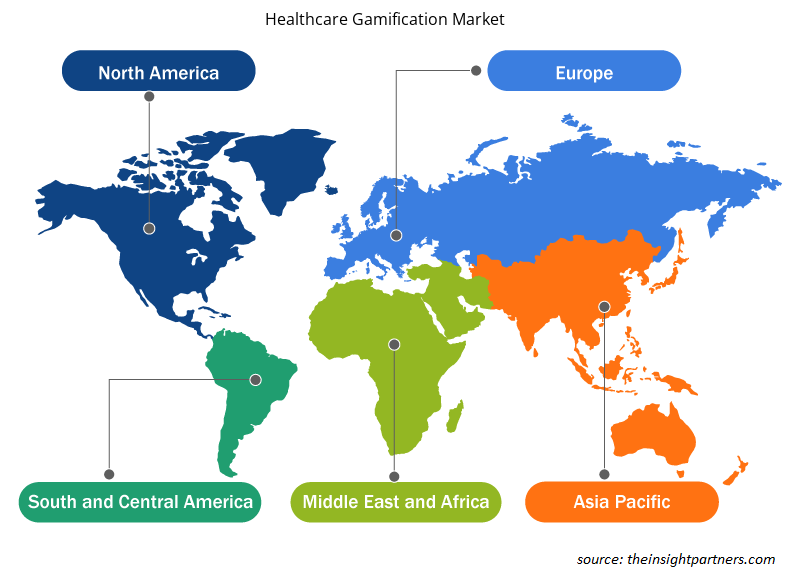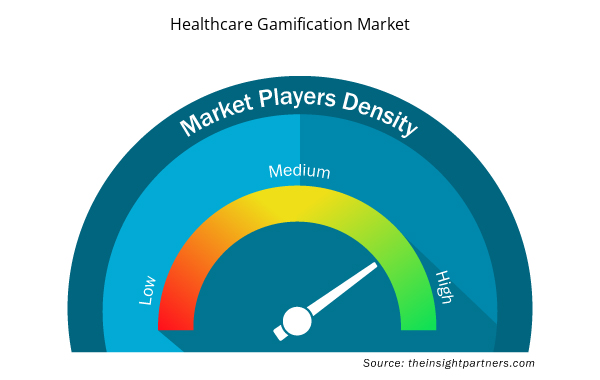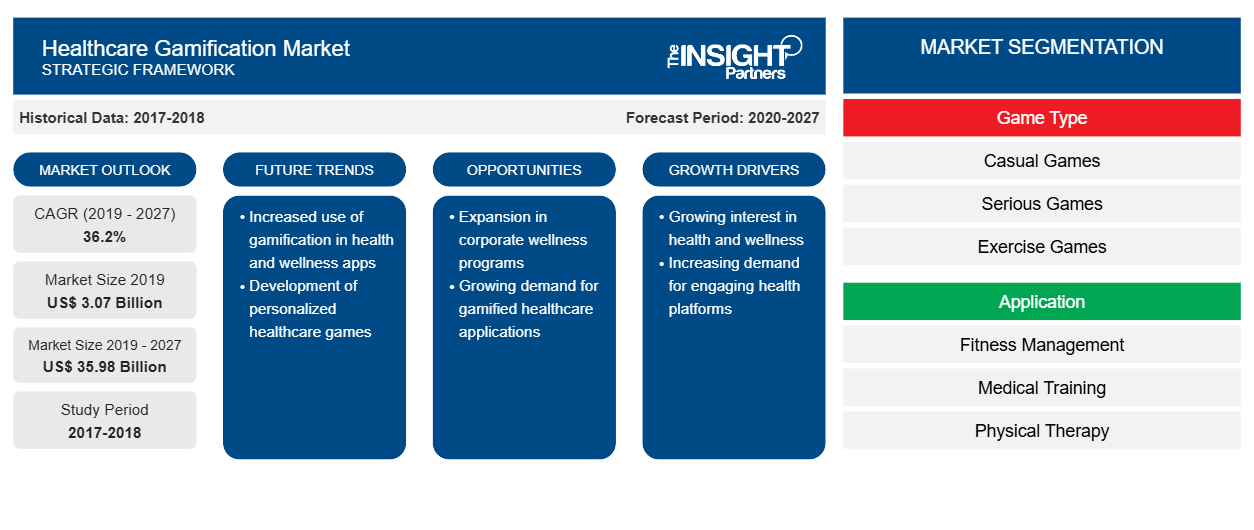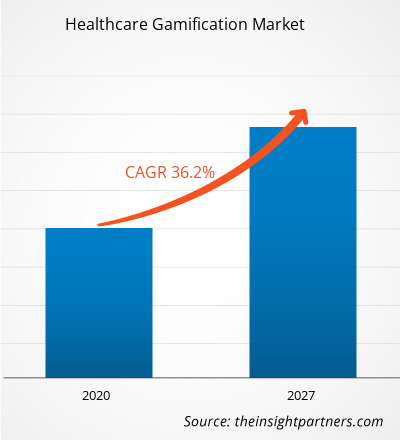[研究报告] 医疗保健游戏化市场预计将从 2019 年的 30.725 亿美元增至 2027 年的 359.827 亿美元。预计 2020 年至 2027 年期间,该市场的复合年增长率为 36.2%。
市场的增长归因于医疗保健领域游戏化应用的日益普及以及技术发布数量的增加等因素。然而,长期用户参与度的困难可能会阻碍市场的增长。
市场洞察
医疗保健领域游戏化应用日益增多
游戏在健康治疗中的应用始于 1975 年初,并在游戏疗法中发挥了重要作用。此外,随着人工智能和增强现实融入医疗保健领域,游戏在治疗方面也引起了人们的关注。游戏为患者提供了表达自己的能力,而大多数患者无法做到这一点,从而帮助专业人员设计出更好的治疗方法,从而获得有效的治疗效果。因此,精神疾病、肌肉骨骼和骨科疾病等慢性疾病的患病率不断上升,这些疾病在一定程度上可以通过游戏技术治疗,预计这将增加对医疗保健游戏化的需求。游戏疗法被发现有助于治疗那些在一生中不断与技术互动的年轻患者。此外,增强现实 (AR) 和虚拟现实 (VR) 等新技术在医疗保健领域的引入正在帮助专业人员治疗患者的精神疾病并协助进行咨询。例如,2016 年,美国的一个游戏设计师团队推出了 DEEP-VR 体验,引导用户在水下环境中学习和对抗焦虑和压力症状。此外,将体育活动融入视频游戏可以将 VR 融入康复治疗中。例如,2017 年 10 月,莱斯大学的学生为儿科物理治疗创建了一款名为 Equilibrium 的视频游戏。该游戏使用 Wii 平衡板以及定制设计的平衡杆,帮助孩子们对提高步行能力和学习平衡感到兴奋。因此,越来越多地将游戏化用于治疗目的,正在推动医疗保健游戏化市场的增长
定制此报告以满足您的需求
您可以免费定制任何报告,包括本报告的部分内容、国家级分析、Excel 数据包,以及为初创企业和大学提供优惠和折扣
- 获取此报告的关键市场趋势。这个免费样品将包括数据分析,从市场趋势到估计和预测。
基于游戏类型的洞察
根据游戏类型,医疗保健游戏化市场分为休闲游戏、严肃游戏和运动游戏。2019 年,休闲游戏占据了市场的最大份额,因为休闲游戏在儿童和 50 岁以上的老年人中的采用率不断提高,因为它有利于提高认知能力,而且不断增长的需求正在加速公司提供各种有趣的休闲游戏。然而,在预测的几年里,运动游戏预计将以更快的速度增长,因为它包括健身和互动身体运动游戏。另一方面,许多医疗保健提供商已经与运动应用程序合作,以鼓励用户养成健康的习惯。例如,医疗保健巨头联合健康保险与《舞蹈,舞蹈革命》的制作者合作开展了一个试点项目,开发了一款适合健身课的游戏,让孩子们站起来,不要坐在沙发上。
基于应用的洞察
按应用划分,医疗游戏化市场分为健身管理、医疗培训、物理治疗等。健身管理领域在 2019 年占据了最大的市场份额。此外,预计同一领域在预测期内将实现最高的复合年增长率。
基于最终用户的洞察
根据最终用户,医疗保健游戏化市场分为企业用户和消费者用户。企业用户部分在 2019 年占据了最大的市场份额,预计在预测期内将实现最高的复合年增长率。
医疗游戏化市场参与者(例如 Cognifit、Mango Health、Bunchball、Ayogo Health Inc、Fitbit, Inc.、Akili Interactive Labs, Inc.、Nike, Inc.、Cohero Health, Inc.、Higi Sh Llc 和 Mysugr)一直在采用多种有机和无机策略来提高其收入和市场地位。例如,2020 年 10 月,TrialCard Incorporated 推出了 Mango Health 2.0 版。此最新版本为第三方医疗服务提供商提供了对 Mango 强大的患者支持模块套件的访问权限。Mango 平台的最新版本将成为即将推出的新型口服溶瘤药的完全集成患者支持计划的一部分。
医疗保健游戏化市场区域洞察
Insight Partners 的分析师已详细解释了预测期内影响医疗游戏化市场的区域趋势和因素。本节还讨论了北美、欧洲、亚太地区、中东和非洲以及南美和中美洲的医疗游戏化市场细分和地理位置。

- 获取医疗保健游戏化市场的区域特定数据
医疗保健游戏化市场报告范围
| 报告属性 | 细节 |
|---|---|
| 2019 年市场规模 | 30.7亿美元 |
| 2027 年市场规模 | 359.8亿美元 |
| 全球复合年增长率(2019 - 2027) | 36.2% |
| 史料 | 2017-2018 |
| 预测期 | 2020-2027 |
| 涵盖的领域 | 按游戏类型
|
| 覆盖地区和国家 | 北美
|
| 市场领导者和主要公司简介 |
|
市场参与者密度:了解其对商业动态的影响
医疗保健游戏化市场正在快速增长,这得益于终端用户需求的不断增长,而这些需求又源于消费者偏好的不断变化、技术进步以及对产品优势的认识不断提高等因素。随着需求的增加,企业正在扩大其产品范围,进行创新以满足消费者的需求,并利用新兴趋势,从而进一步推动市场增长。
市场参与者密度是指在特定市场或行业内运营的企业或公司的分布情况。它表明相对于给定市场空间的规模或总市场价值,有多少竞争对手(市场参与者)存在于该市场空间中。
在医疗保健游戏化市场运营的主要公司有:
- 认知功能
- 芒果健康
- 邦奇球
- Ayogo 健康公司
- Fitbit 公司
免责声明:上面列出的公司没有按照任何特定顺序排列。

- 获取医疗保健游戏化市场顶级关键参与者概述
医疗保健游戏化市场——按游戏类型划分
- 休闲游戏
- 严肃游戏
- 运动游戏
医疗保健游戏化市场——按应用划分
- 健身管理
- 医疗培训
- 物理治疗
- 其他的
医疗保健游戏化市场——按最终用户划分
- 企业用户
- 消费者用户
医疗保健游戏化市场 – 按地区划分
北美
- 我们
- 加拿大
- 墨西哥
欧洲
- 法国
- 德国
- 意大利
- 英国
- 西班牙
- 欧洲其他地区
亚太地区 (APAC)
- 中国
- 印度
- 韩国
- 日本
- 澳大利亚
- 亚太其他地区
中东和非洲 (MEA)
- 南非
- 沙特阿拉伯
- 阿联酋
- 中东和非洲其他地区
南美洲和中美洲
- 巴西
- 阿根廷
- 南美洲和中美洲其他地区
公司简介
- 认知功能
- 芒果健康
- 邦奇球
- Ayogo 健康公司
- Fitbit 公司
- Akili 互动实验室有限公司
- 耐克公司
- Cohero Health, Inc.
- Higi Sh有限责任公司
- 米苏格尔
- 历史分析(2 年)、基准年、预测(7 年)及复合年增长率
- PEST 和 SWOT 分析
- 市场规模价值/数量 - 全球、区域、国家
- 行业和竞争格局
- Excel 数据集



Report Coverage
Revenue forecast, Company Analysis, Industry landscape, Growth factors, and Trends

Segment Covered
This text is related
to segments covered.

Regional Scope
North America, Europe, Asia Pacific, Middle East & Africa, South & Central America

Country Scope
This text is related
to country scope.
常见问题
Global healthcare gamification market is segmented by region into North America, Europe, Asia Pacific, Middle East &Africa and South & Central America. The North American region is the largest shareholder and Asia Pacific is the fastest growing market for healthcare gamification. The healthcare gamification market is estimated to have a larger share in the United States. The growth of the healthcare gamification market in the United States is expected due to presence of leading players establishing their primary base, rising incidences of acute and chronic diseases among the population and technological advancements that is adaptive towards gamification in healthcare sector.
Gamification involves implementing game design techniques, game mechanics, and game style to solve problems, engage audiences, and make tasks more fun and engaging. Gamification is employed in health and wellness apps related to disease prevention, self-management, medical education-related simulations, medication adherence, and telehealth programs. In healthcare, it is primarily useful for behavioral changes, incentivizing people to increase their wellness by performing game-like tasks and receiving rewards.
Factors such as increasing adoption of gamification in healthcare and rise in number of launches are likely to drive the market growth. However, difficulties in long-term user engagement are anticipated to hamper the growth of the market.
Trends and growth analysis reports related to Technology, Media and Telecommunications : READ MORE..
The List of Companies - Healthcare Gamification Market
- Cognifit
- Mango Health
- Bunchball
- Ayogo Health Inc.
- Fitbit, Inc.
- Akili Interactive Labs, Inc.
- Nike, Inc.
- Cohero Health, Inc.
- Higi Sh Llc
- Mysugr
The Insight Partners performs research in 4 major stages: Data Collection & Secondary Research, Primary Research, Data Analysis and Data Triangulation & Final Review.
- Data Collection and Secondary Research:
As a market research and consulting firm operating from a decade, we have published and advised several client across the globe. First step for any study will start with an assessment of currently available data and insights from existing reports. Further, historical and current market information is collected from Investor Presentations, Annual Reports, SEC Filings, etc., and other information related to company’s performance and market positioning are gathered from Paid Databases (Factiva, Hoovers, and Reuters) and various other publications available in public domain.
Several associations trade associates, technical forums, institutes, societies and organization are accessed to gain technical as well as market related insights through their publications such as research papers, blogs and press releases related to the studies are referred to get cues about the market. Further, white papers, journals, magazines, and other news articles published in last 3 years are scrutinized and analyzed to understand the current market trends.
- Primary Research:
The primarily interview analysis comprise of data obtained from industry participants interview and answers to survey questions gathered by in-house primary team.
For primary research, interviews are conducted with industry experts/CEOs/Marketing Managers/VPs/Subject Matter Experts from both demand and supply side to get a 360-degree view of the market. The primary team conducts several interviews based on the complexity of the markets to understand the various market trends and dynamics which makes research more credible and precise.
A typical research interview fulfils the following functions:
- Provides first-hand information on the market size, market trends, growth trends, competitive landscape, and outlook
- Validates and strengthens in-house secondary research findings
- Develops the analysis team’s expertise and market understanding
Primary research involves email interactions and telephone interviews for each market, category, segment, and sub-segment across geographies. The participants who typically take part in such a process include, but are not limited to:
- Industry participants: VPs, business development managers, market intelligence managers and national sales managers
- Outside experts: Valuation experts, research analysts and key opinion leaders specializing in the electronics and semiconductor industry.
Below is the breakup of our primary respondents by company, designation, and region:

Once we receive the confirmation from primary research sources or primary respondents, we finalize the base year market estimation and forecast the data as per the macroeconomic and microeconomic factors assessed during data collection.
- Data Analysis:
Once data is validated through both secondary as well as primary respondents, we finalize the market estimations by hypothesis formulation and factor analysis at regional and country level.
- Macro-Economic Factor Analysis:
We analyse macroeconomic indicators such the gross domestic product (GDP), increase in the demand for goods and services across industries, technological advancement, regional economic growth, governmental policies, the influence of COVID-19, PEST analysis, and other aspects. This analysis aids in setting benchmarks for various nations/regions and approximating market splits. Additionally, the general trend of the aforementioned components aid in determining the market's development possibilities.
- Country Level Data:
Various factors that are especially aligned to the country are taken into account to determine the market size for a certain area and country, including the presence of vendors, such as headquarters and offices, the country's GDP, demand patterns, and industry growth. To comprehend the market dynamics for the nation, a number of growth variables, inhibitors, application areas, and current market trends are researched. The aforementioned elements aid in determining the country's overall market's growth potential.
- Company Profile:
The “Table of Contents” is formulated by listing and analyzing more than 25 - 30 companies operating in the market ecosystem across geographies. However, we profile only 10 companies as a standard practice in our syndicate reports. These 10 companies comprise leading, emerging, and regional players. Nonetheless, our analysis is not restricted to the 10 listed companies, we also analyze other companies present in the market to develop a holistic view and understand the prevailing trends. The “Company Profiles” section in the report covers key facts, business description, products & services, financial information, SWOT analysis, and key developments. The financial information presented is extracted from the annual reports and official documents of the publicly listed companies. Upon collecting the information for the sections of respective companies, we verify them via various primary sources and then compile the data in respective company profiles. The company level information helps us in deriving the base number as well as in forecasting the market size.
- Developing Base Number:
Aggregation of sales statistics (2020-2022) and macro-economic factor, and other secondary and primary research insights are utilized to arrive at base number and related market shares for 2022. The data gaps are identified in this step and relevant market data is analyzed, collected from paid primary interviews or databases. On finalizing the base year market size, forecasts are developed on the basis of macro-economic, industry and market growth factors and company level analysis.
- Data Triangulation and Final Review:
The market findings and base year market size calculations are validated from supply as well as demand side. Demand side validations are based on macro-economic factor analysis and benchmarks for respective regions and countries. In case of supply side validations, revenues of major companies are estimated (in case not available) based on industry benchmark, approximate number of employees, product portfolio, and primary interviews revenues are gathered. Further revenue from target product/service segment is assessed to avoid overshooting of market statistics. In case of heavy deviations between supply and demand side values, all thes steps are repeated to achieve synchronization.
We follow an iterative model, wherein we share our research findings with Subject Matter Experts (SME’s) and Key Opinion Leaders (KOLs) until consensus view of the market is not formulated – this model negates any drastic deviation in the opinions of experts. Only validated and universally acceptable research findings are quoted in our reports.
We have important check points that we use to validate our research findings – which we call – data triangulation, where we validate the information, we generate from secondary sources with primary interviews and then we re-validate with our internal data bases and Subject matter experts. This comprehensive model enables us to deliver high quality, reliable data in shortest possible time.


 获取此报告的免费样本
获取此报告的免费样本